Gaming with a "Prosumer" card? Yes, but…
AMD itself says that the Radeon Vega Frontier Edition is not an explicitly gaming graphics card, but you can still do so with it. Another problem also arises in the driver's question, because what will come next, what will not? Was it, or are we still waiting for the bang when Vega breaks through the sound barrier? In any case, we are at the end of July or At the beginning of August, smarter, because something is yet to come, the sparrows are now whistling from the roofs. But no one knows what exactly, because they don't do it clearly enough.
That is precisely why we are not going to test further speculative benchmarks for prosperity and spoilage, which are likely to be traded under binary garbage again at the end of the month anyway. Instead, we selected an exemplary benchmark for each of the top three categories, providing it with detailed graphs and analyses. In addition, we test in a resolution that is most likely to be the "Prosumer" target group and which also does not create space for any CPU limitations.
What we are doing, however, is expanding or Change the selection of the maps now tested. Only the Quadro P6000 as the equivalent of the Titan XP is allowed to compete again, because even with this card it can be played quite relaxed and fluid.
DirectX 11 with The Witcher 3
This game is now almost a classic and has been optimized by both driver teams. You can live with this first, because it is at least one constant that is necessary for an objective assessment of an average expected performance. If you leave Nvidia's Hairworks out, each of the two manufacturers is likely to squeeze the best out of the drivers by now. And that is exactly what we want. First of all, let's just look at the pure FPS numbers, i.e. what you find everywhere:
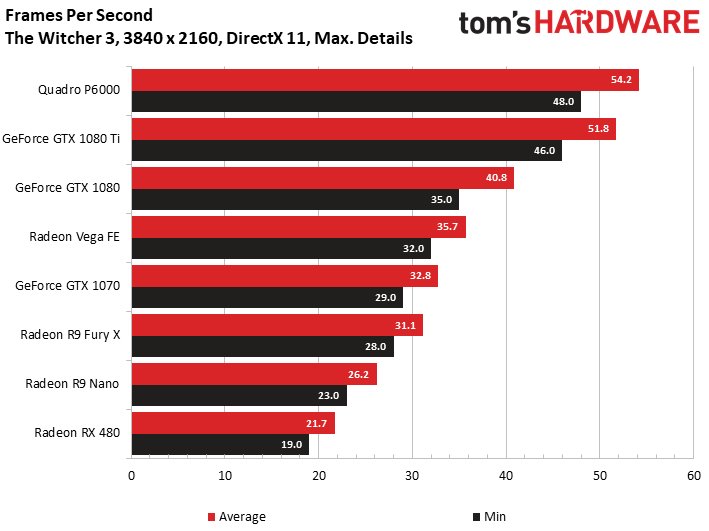
Next, we're interested in the corresponding FPS curve over the course of the entire benchmark run:
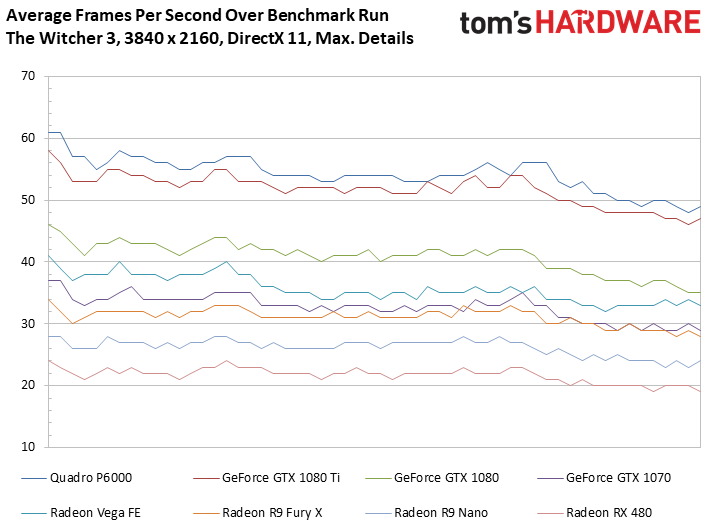
Of course, the pure frame times are also an important part of the consideration. That's why we now compare all maps as both curve and bar charts:
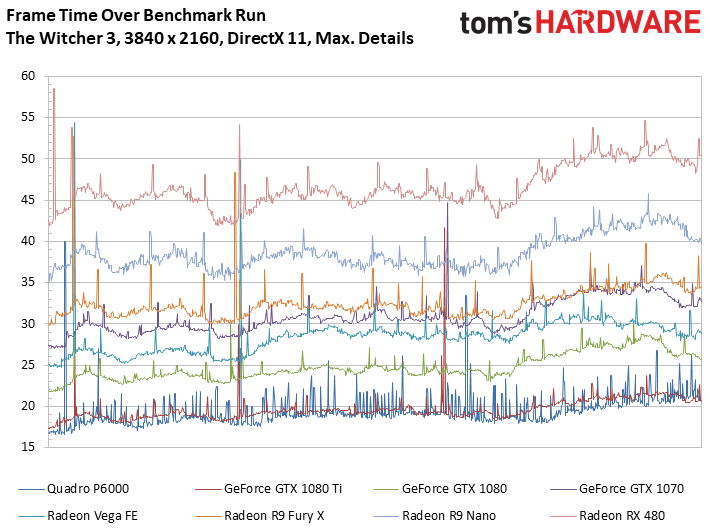
Up to the Radeon Vega FE, the picture looks quite neat, but the difference between the Quadro P6000, which is slowed down by its power limit, and the GeForce GTX 1080 Ti is quite remarkable. The card, which is very restrictive due to Boost, acts quite hilarious, which you can also see well in the bar graphic:
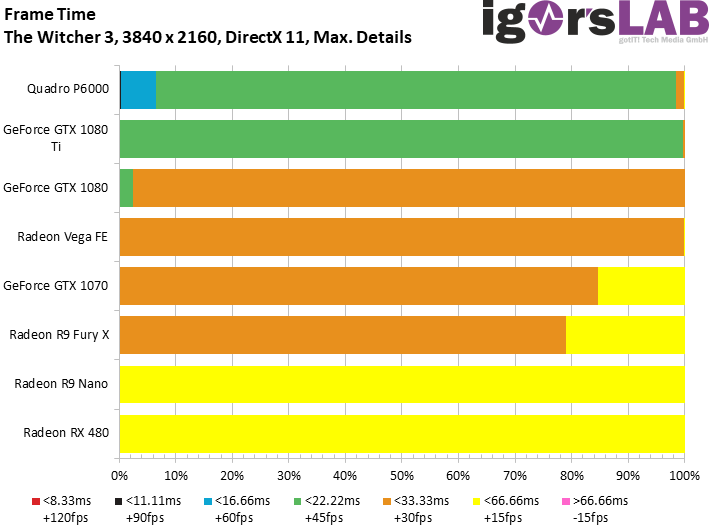
In order to be able to evaluate all this even better, we have to compare the variances of the Frame-Times with each other and in the end also strive for our Unevenness Index, which can reflect the immersion of the player quite realistically. The Radeon Vega FE is not the fastest card in the field, but overall quite balanced and significantly better than the Fiji and Polaris cards. Even the GTX 1080 Ti and Quadro P6000 have to fit ahead of the three first-place finishers.
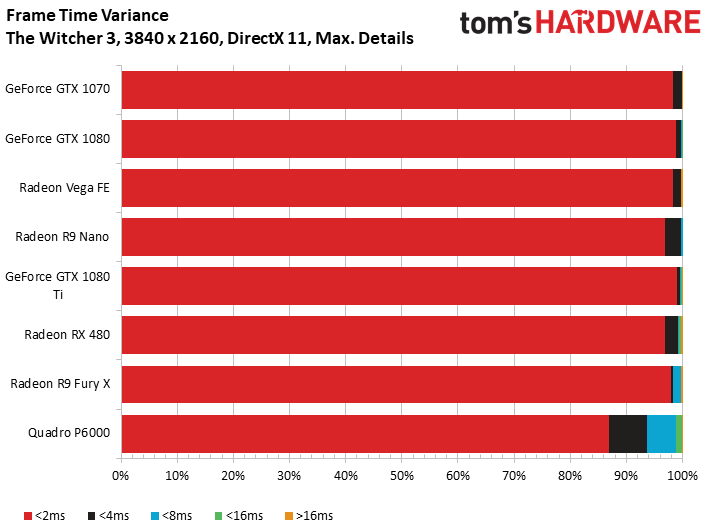
However, variances alone are not the only truth, because you simply have to look at it in the context of the basic performance. There is the Unevenness Index for this. The Radeon Vega FE can stand out from all in-house predecessor models, but in the end only positions itself between the GeForce GTX 1080 and the GeForce GTX 1070, with the tendency towards the GeForce GTX 1080:
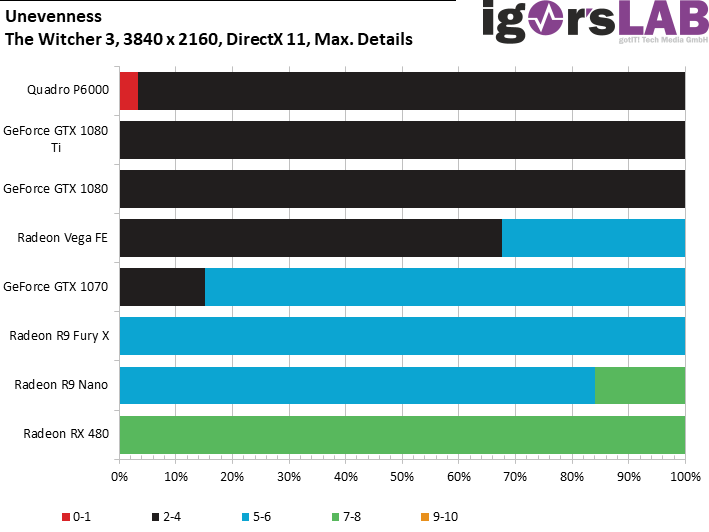 For the important variances and above all the subjective playability impression, we have summarized the two individual graphics for each of the tested maps once again for browsing in a gallery:
For the important variances and above all the subjective playability impression, we have summarized the two individual graphics for each of the tested maps once again for browsing in a gallery:
(K)an interim conclusion to DirectX11
The results are, of course, very sobering, for the time being. The Radeon Vega FE performs even more slowly than a GeForce GTX 1080 in reference design, which is simply not enough for the driven effort. However, no one knows when and if something can change in this, so we do not want to draw a conclusion yet. A cause study with any memory bandwidths or other bottle necks is just as speculative and wasted time as long as AMD has not dropped the pants.
- 1 - Einführung und Übersicht
- 2 - Details zu Architektur und HBM2-Speicher
- 3 - Demontage, Kühler und Interposer-Details
- 4 - Platinendesign und Detailinformationen
- 5 - Benchmark-Intro, 2D-Troughput und -Performance
- 6 - 3D Workstation- und Design-Benchmarks
- 7 - Gaming-Performance: DirectX 11
- 8 - Gaming-Performance: DirectX12
- 9 - Gaming-Performance: Vulkan/OpenGL 4.5
- 10 - Leistungsaufnahme im Detail
- 11 - Takt, Temperaturen und Geräuschemission
- 12 - Zusammenfassung und Fazit

































Kommentieren